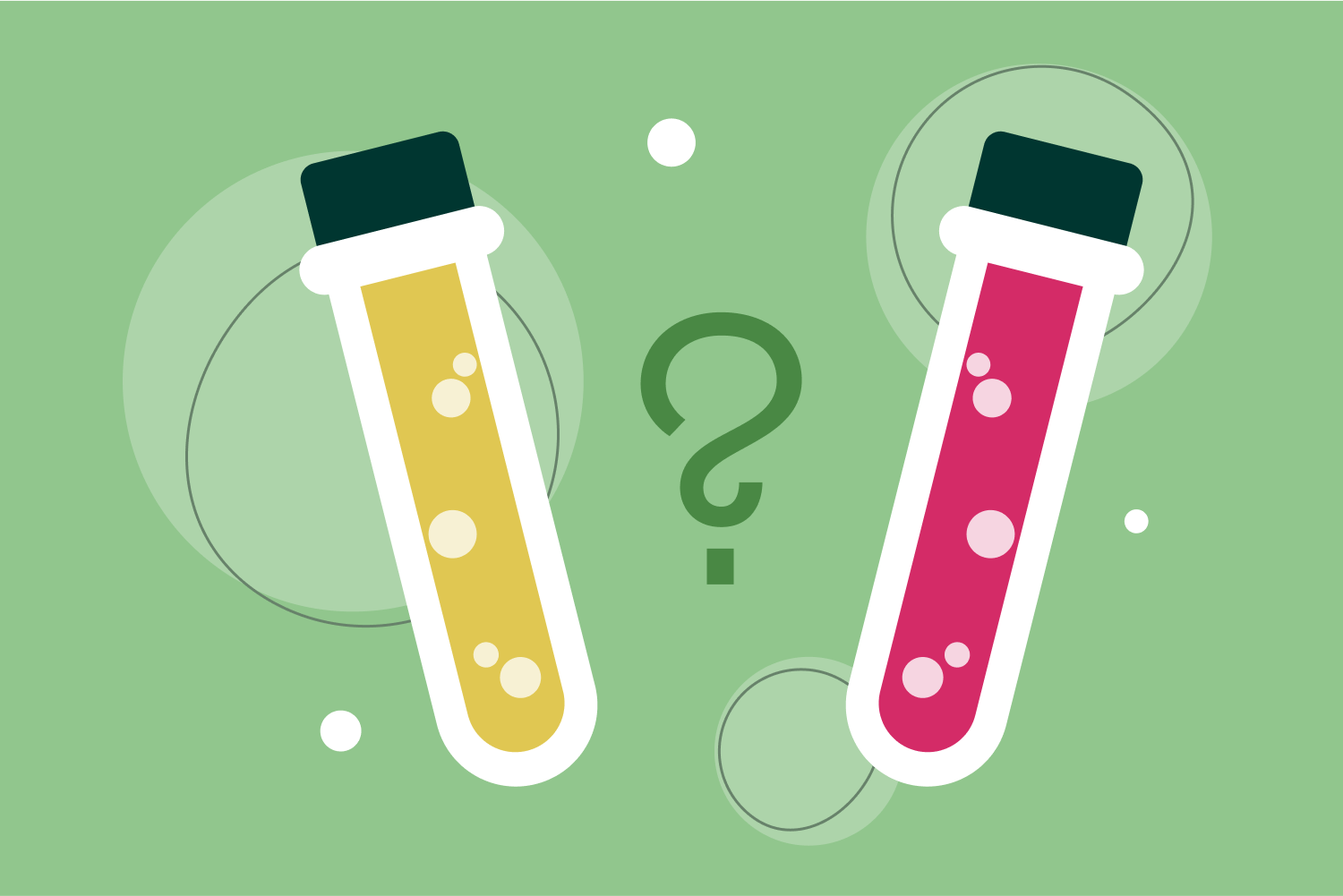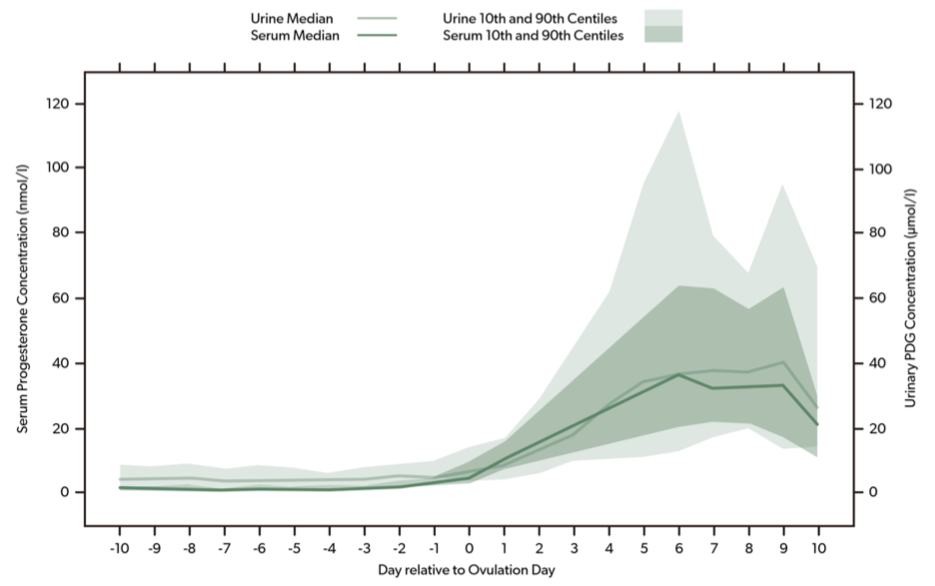

There are two different ways to confirm ovulation. The first option is to have a blood test, and the second option is to take a urinary test. Even though both methods are accurate, it is important to understand that the numerical results of each test will be completely different – and that’s okay!
To help you better understand these differences, here is a look at the science behind how blood serum progesterone and urine PdG are linked, and considerations to make when testing for each. We’ll also cover some of your most frequently asked questions regarding the accuracy of Mira’s Confirm Wands which detect PdG.
Yes. A PdG (pregnanediol-3-glucuronide) urine test measures the amount of metabolized progesterone in your urine. On the other hand, a blood serum test measures the amount of progesterone found in your blood before it has been metabolized.
Another major difference between PdG testing and progesterone blood testing is the unit of measurement. Serum progesterone is measured in nanograms per milliliter (ng/mL) while PdG is measured in micrograms per milliliter (μg/ml).
Even though there is a clear distinction between PdG and blood progesterone, they are still directly correlated and follow similar patterns throughout the menstrual cycle.
Please note that Mira tracks PdG. All the information provided in this article about Progesterone is purely educational. Please always refer to your healthcare provider.
Before we dive deeper into the differences between urinary PdG and serum progesterone, here’s a quick reminder about the role of progesterone in the female reproductive system.
In non-pregnant individuals, progesterone is produced by a temporary gland in the ovary just after ovulation. Once produced, it then flows throughout the bloodstream and binds with its relevant receptors. It is then metabolized by the kidneys and released in the urine as PdG (pregnanediol-3-glucuronide).
The primary role of progesterone is to regulate the menstrual cycle and prepare the body for conception. If conception does occur, the body continues to produce progesterone in order to support early pregnancy. If conception does not occur, progesterone levels drop and menstruation begins.
Testing progesterone levels is commonly used to confirm ovulation. This can be helpful for those who are planning a pregnancy, struggling with infertility, and/or managing conditions like polycystic ovary syndrome (PCOS) or endometriosis.
The term “serum progesterone” simply means progesterone that is found in the blood.
It is most commonly used by doctors when they order a “serum progesterone test”, which is a type of blood test that measures numeric progesterone levels in the body.
Urinary PdG (pregnanediol-3-glucuronide) is a direct reflection of the progesterone levels in the blood. This is because after progesterone circulates through the bloodstream, it is then metabolized and released in the urine as PdG.
PdG can be detected with Mira’s confirm wands, which measure the numeric value of PdG in urine. It is also possible to test for PdG with a Proovtest, however, this test can only determine whether or not your PdG levels are elevated enough to confirm ovulation.
Please note that urine PdG should only be used for confirming ovulation. Mira Confirm Wands are not designed nor approved or cleared for monitoring early pregnancy status, miscarriage, fetal health tracking or other diagnostic uses for which progesterone might be an indicator.
Even though PdG and blood serum progesterone are two different chemicals, they do share the same fluctuation patterns in the body. This means that both blood serum progesterone and PdG can be used to confirm ovulation.
To illustrate this, here is a look at a summary of PdG test results from Mira users over the course of one cycle.
As you can see in the above graph, the X-axis is the day relative to ovulation and the Y-axis is the numerical PdG value tested by a Mira Confirm Wand. The light green area shows the variation in PdG levels, and the dark line represents the average of all recorded PdG levels.
Here we can see that on average, PdG rises slightly right before ovulation before increasing rapidly after ovulation. This is a direct reflection of serum progesterone levels in the blood.
You may notice that PdG levels can vary greatly among individuals – and that’s okay! Everyone’s cycle is different, and it’s normal to see some variation in test results. The most important thing to take note of is not the numerical measurement, but rather in how the measurements increase and decrease throughout the cycle.
In another graph below, we can see how urinary PdG measurements compare to serum progesterone measurements in the blood.

In this graph, the X-axis is again the day relative to ovulation. The first Y-axis on the lefthand side denotes the numerical serum progesterone values (measured in nmol/l) and the second Y-axis on the righthand side is the numerical PdG value (measured in μmol/l). The light green area shows the variation in PdG levels and the dark green area shows the variation in blood progesterone levels.
Again, we can see that on average, both progesterone and PdG begin to rise around ovulation. Although exact measurements vary among individuals, there is a strong correlation between PdG and blood progesterone.
Measuring your exact blood serum progesterone levels will require a visit to your doctor’s office for a blood test. This will involve a nurse drawing a blood sample and sending it off to be analyzed at a laboratory. Your doctor will then give you a call to let you know what your exact blood progesterone levels were at the time of your test.
Progesterone blood testing is particularly helpful for those who feel that they need extra guidance from a medical professional to interpret their results. However, it’s important to bear in mind that progesterone is secreted in pulses over the course of the day (and night). This means that one single blood test may not show the most accurate picture of your overall progesterone levels – which can vary from minute to minute.
To get the most out of your test, doctors often recommend having your blood drawn on day 21 of your cycle. However, cycle lengths and patterns can vary greatly so this may not be the best day to test for each and every patient.
Another point for consideration is the fact that having regular blood tests at your doctor’s office can get expensive – especially if your doctor or insurance does not consider it “necessary” for you to have a progesterone blood test.
Recent advancements in technology have now made it possible to test for urinary PdG at home. This can be done with Mira’s Confirm Wands or a Proov test.
Taking a Proov test is very similar to taking a pregnancy test. All you have to do is test a urine sample, and the test will confirm whether or not your PdG levels are high enough to confirm ovulation. it’s important to note that you will not receive your exact numeric PdG level, but rather will only receive a yes or no answer about whether or not ovulation has occurred.
Testing PdG with Mira requires the Mira Analyzer, Mira app, and Confirm Wands. First, you must use a Confirm Wand to take a urine sample. Then, insert the wand into the analyzer and your numeric PdG results will be displayed. You can then use the Mira app to keep track of all of your PdG test results over time.
Unlike Proovtest which is based on a fixed threshold, Mira is designed to track hormonal patterns and fluctuations. This is a huge advantage for individuals who ovulate, but their PdG levels are too low for a Proovtest to confirm it.

Track all key fertility hormones at once